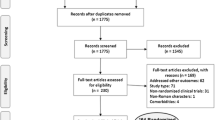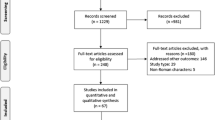Abstract
Background: Use of unmodified interferon α-2a in chronic hepatitis C is associated with impaired health-related quality of life during therapy. Treatment with peginterferon α-2a (40kD) provides an improved sustained response over unmodified interferon α-2a.
Objectives: To compare health-related quality of life during treatment for patients receiving peginterferon α-2a (40kD) [Pegasys®] versus unmodified interferon α-2a [Roferon®].
Design: A randomised, international, multicentre, open-label, parallel group study.
Setting: 36 centres worldwide.
Patients: Interferon-naïve patients (n = 531) with chronic hepatitis C.
Interventions: Peginterferon α-2a (40kD) 180µg once a week (n = 267) for 48 weeks or unmodified interferon α-2a 6 million IU three times a week for 12 weeks followed by 36 weeks of 3 million IU three times a week (n = 264).
Measurements: Fatigue Severity Scale and 36-item Short-Form Health Survey (SF-36).
Results: At weeks 2 and 12, differences favouring peginterferon α-2a (40kD) were seen on seven of eight domains and both summary scores of the SF-36 (p < 0.05 to p < 0.01). At weeks 2, 12 and 24, patients receiving peginterferon α-2a (40kD) had less disabling fatigue (p < 0.01) than those receiving unmodified interferon α-2a.
Conclusion: Treatment with peginterferon α-2a (40kD) is associated with less disabling fatigue and less impairment in patient functioning and well-being during treatment than unmodified interferon α-2a. In addition to safety and efficacy, the impact on health-related quality of life may be an important consideration for physicians when selecting an optimal treatment regimen.




Similar content being viewed by others
Notes
Use of tradenames is for product identification only and does not imply endorsement.
References
WHO Consultation. Global surveillance and control of hepatitis C: report of a WHO consultation organized in collaboration with the Viral Hepatitis Prevention Board, Antwerp, Belgium. J Viral Hepat 1999; 6: 35–47
Alter MJ, Kruszon-Moran D, Nainan OV, et al. The prevalence of hepatitis C virus infection in the United States, 1988 through 1994. N Engl J Med 1999; 341: 556–62
Davis GL, Balart LA, Schiff ER, et al. Assessing health-related quality of life in chronic hepatitis C using the Sickness Impact Profile. Clin Ther 1994; 16: 334–43
Ware J, Bungay K, Bandek B, et al. Assessment of the health-related quality of life (HRQL) of patients with chronic hepatitis C (CHC). Gastroenterology 1994; 106: A393
Ware J, Bayliss MS, Mannocchia M, et al. Health-related quality of life in chronic hepatitis C: impact of disease and treatment response. The Interventional Therapy Group. Hepatology 1999; 30: 550–5
Bonkovsky HL, Woolley JM. Reduction of health-related quality of life in chronic hepatitis C and improvement with interferon therapy. The Consensus Interferon Study Group. Hepatology 1999; 29: 264–70
Carithers Jr RL, Emerson SS. Therapy of hepatitis C: meta-analysis of interferon alfa-2b trials. Hepatology 1997; 26: 83S–8S
Poynard T, Leroy V, Cohard M, et al. Meta-analysis of interferon randomized trials in the treatment of viral hepatitis C: effects of dose and duration. Hepatology 1996; 24: 778–89
Farrell G. Therapy of hepatitis C: interferon alfa-n1 trials. Hepatology 1997; 26: 96S–100S
Poynard T, Marcellin P, Lee SS, et al. Randomised trial of interferon alpha2b plus ribavirin for 48 weeks or for 24 weeks versus interferon alpha2b plus placebo for 48 weeks for treatment of chronic infection with hepatitis C virus. Lancet 1998; 352: 1426–32
McHutchison JG, Gordon SC, Schiff ER, et al. Interferon alfa-2b alone or in combination with ribavirin as initial treatment for chronic hepatitis C. N Engl J Med 1998; 339: 1485–92
Barkhuizen A, Rosen HR, Wolf S, et al. Musculoskeletal pain and fatigue are associated with chronic hepatitis C: a report of 239 hepatology clinic patients. Am J Gastroenterol 1999; 94: 1355–60
Cotler SJ, Wartelle CF, Larson AM, et al. Pretreatment symptoms and dosing regimen predict side-effects of interferon therapy for hepatitis C. J Viral Hepat 2000; 7: 211–7
Poynard T, Ratziu V, Benhamou Y, et al. Natural history of HCV infection. Baillieres Best Pract Res Clin Gastroenterol 2000; 14: 211–28
Dusheiko G. Side effects of alpha interferon in chronic hepatitis C. Hepatology 1997; 26: 112S–21S
Neary MP, Cort S, Bayliss MS, et al. Sustained virologic response is associated with improved health-related quality of life in relapsed chronic hepatitis C patients. Semin Liver Dis 1999; 19: 77–85
Zeuzem S, Feinman SV, Rasenack J, et al. Peginterferon Alfa-2a in Patients with Chronic Hepatitis C. N Engl J Med 2000; 343: 1666–72
Krupp LB, LaRocca NG, Muir-Nash J, et al. The fatigue severity scale: application to patients with multiple sclerosis and systemic lupus erythematosus. Arch Neurol 1989; 46: 1121–3
Kleinman L, Zodet M, Hakim Z, et al. Psychometric evaluation of the fatigue severity scale for use in chronic hepatitis C. Qual Life Res 2000; 9: 499–508
Ware JEJ, Snow KK, Kosinski M, et al. SF-36 health survey: manual and interpretation guide. Boston: The Health Institute, New England Medical Center, 1993
Ware J, Kosinski M, Keller S. SF-36 Physical and mental health summary scores: a user’s manual. Boston: The Health Institute, New England Medical Center, 1994
Foster GR, Goldin RD, Thomas HC. Chronic hepatitis C virus infection causes a significant reduction in quality of life in the absence of cirrhosis. Hepatology 1998; 27: 209–12
Grey-Amonk P, Wild D, Hakim Z, et al. The cross-cultural adaptation of the fatigue severity scale. Presented at the Drug Information Association Quality of Life Symposium, Hilton Head; 2000 Apr 2–4; South Carolina
Bernstein D, Kleinman L, Barker CM, et al. Relationship of health-related quality of life to treatment adherence and sustained response in chronic hepatitis C patients. Hepatology 2002; 35: 704–8
Acknowledgements
This work was supported by a grant from F. Hoffmann-La Roche Ltd, Basel, Switzerland.
Amy Lin, Neil Wintfeld, and Jesse Green are employees of F. Hoffmann-La Roche. Dr. Eric Yoshida has been an investigator of clinical trials sponsored by Roche-Canada. He has received honoraria for Continuing Medical Education lectures sponsored by Roche-Canada. He has received honoraria for an article on hepatitis C that appeared on a Roche-sponsored website. He has attended Medical Advisory Committee Meetings at Roche-Canada. All other authors have not disclosed any affiliations and/or financial interests with the pharmaceutical industry.
Author information
Authors and Affiliations
Corresponding author
Rights and permissions
About this article
Cite this article
Rasenack, J., Zeuzem, S., Feinman, S.V. et al. Peginterferon α-2a (40kD) [Pegasys®] Improves HR-QOL Outcomes Compared with Unmodified Interferon α-2a [Roferon®-A]. Pharmacoeconomics 21, 341–349 (2003). https://doi.org/10.2165/00019053-200321050-00005
Published:
Issue Date:
DOI: https://doi.org/10.2165/00019053-200321050-00005




